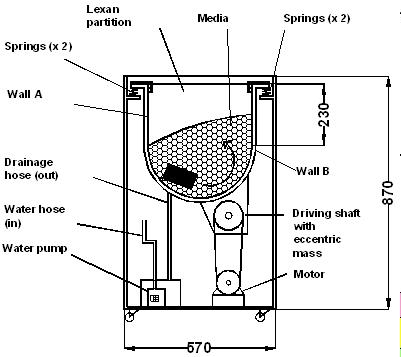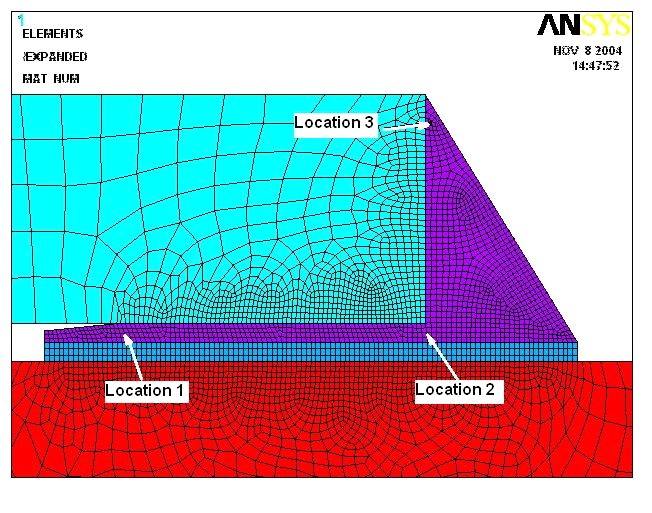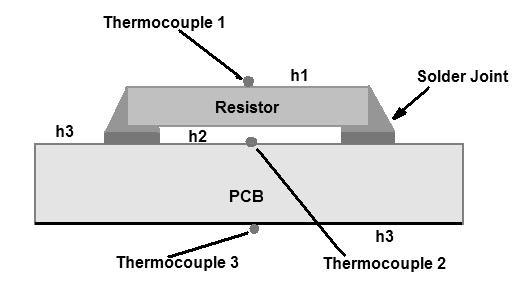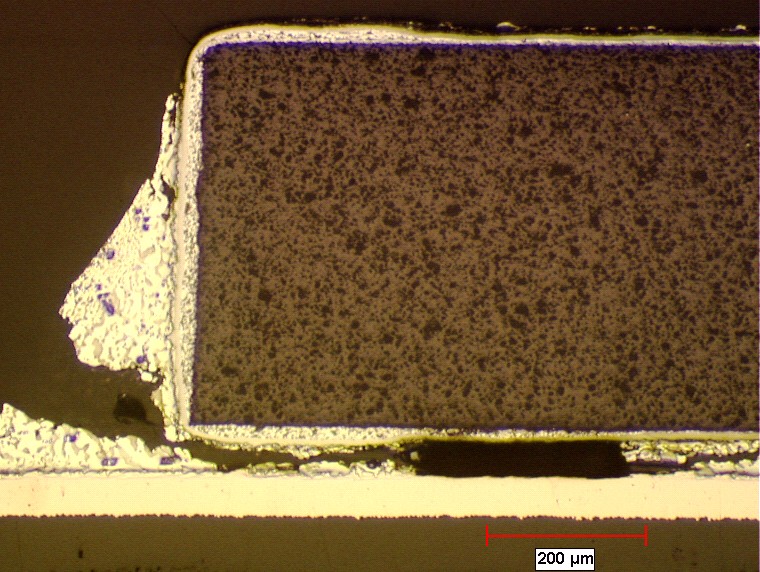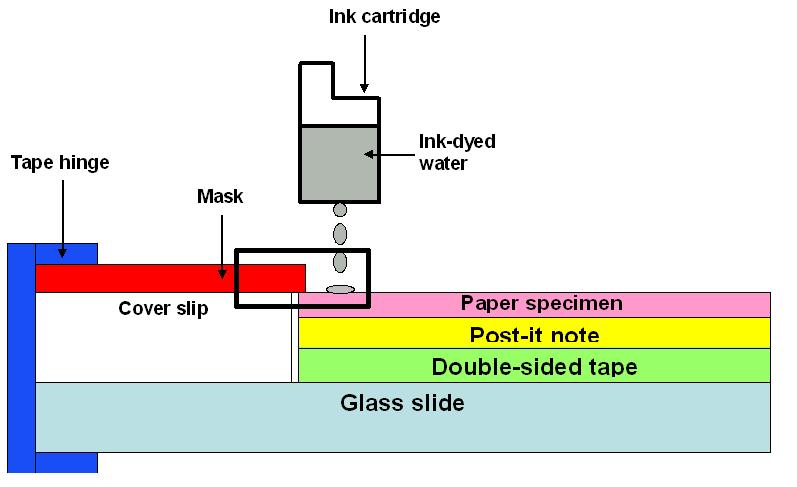Materials
and Process Mechanics Laboratory
University of Toronto
Research Activities
Our research focuses on the mechanics aspects of the performance and processing of materials and manufactured goods. Many of our projects are collaborations with industrial partners, and graduate students lead most of them as part of their M.A.Sc. or Ph.D. research. The publication list below provides a good indication of the nature of our work.
Current and recently completed projects include:
1. Tribology



![]() Measuring
the transient contact forces exerted on a part by the abrasive media in
a vibratory
finisher. These data together with measurements of hardness
and
roughness changes as a function of time and finishing conditions are
being used
to understand the mechanics of this widely-used surface finishing
process. Analytical and finite element models are being developed
to
predict the outcome of vibratory finishing as a function of process
parameters. The discrete element method
(DEM) is being used to model the vibrationally fluidized flow of the
media in a
vibratory finisher.
Measuring
the transient contact forces exerted on a part by the abrasive media in
a vibratory
finisher. These data together with measurements of hardness
and
roughness changes as a function of time and finishing conditions are
being used
to understand the mechanics of this widely-used surface finishing
process. Analytical and finite element models are being developed
to
predict the outcome of vibratory finishing as a function of process
parameters. The discrete element method
(DEM) is being used to model the vibrationally fluidized flow of the
media in a
vibratory finisher.

![]() Abrasive jet micro-machining
is being studied
experimentally and analytically in order to develop models to predict
the
eroded surface profile, the rate of material removal, and the roughness
of the
machined surfaces. Channels, holes and
multi-level planar areas are machined in glass, silicon and polymers
with and
without masking. Applications are found
in microfluidics, MEMs and opto-electronic devices.
Abrasive jet micro-machining
is being studied
experimentally and analytically in order to develop models to predict
the
eroded surface profile, the rate of material removal, and the roughness
of the
machined surfaces. Channels, holes and
multi-level planar areas are machined in glass, silicon and polymers
with and
without masking. Applications are found
in microfluidics, MEMs and opto-electronic devices.
![]() Understanding the basic
mechanisms by which high-speed particles remove coatings in the process
of blast
cleaning. This research included the development of models to
predict the
process parameters that most efficiently remove a given coating. Experiments examined particles of glass,
plastic and wheat starch impacting against coatings that are eroded in
one of
three ways: delamination, ploughing erosion, micro-machining erosion.
Understanding the basic
mechanisms by which high-speed particles remove coatings in the process
of blast
cleaning. This research included the development of models to
predict the
process parameters that most efficiently remove a given coating. Experiments examined particles of glass,
plastic and wheat starch impacting against coatings that are eroded in
one of
three ways: delamination, ploughing erosion, micro-machining erosion.
![]() Computer
modeling of the rebound of particle streams from solid surfaces
including collisions with incoming particles. Applications are in
shot
peening, blast cleaning and machining using erosive particle streams.
Computer
modeling of the rebound of particle streams from solid surfaces
including collisions with incoming particles. Applications are in
shot
peening, blast cleaning and machining using erosive particle streams.
2. Microelectronics Packaging
![]() Finite element modelling of
the warpage that can occur in printed circuit boards during
wave soldering.
Finite element modelling of
the warpage that can occur in printed circuit boards during
wave soldering.
![]() Accelerated thermal
fatigue testing and finite element modeling of solder joint life in
microelectronic components. Our objective is to understand the
role of
test variables such as temperature ramp rate and dwell time so that
manufacturers can reduce product testing times. We are also
obtaining new
data for lead-free solders and assessing the accuracy of thermal
fatigue
models.
Accelerated thermal
fatigue testing and finite element modeling of solder joint life in
microelectronic components. Our objective is to understand the
role of
test variables such as temperature ramp rate and dwell time so that
manufacturers can reduce product testing times. We are also
obtaining new
data for lead-free solders and assessing the accuracy of thermal
fatigue
models.
![]() Distortion in adhesive
connections between optical fibers can cause significant signal
loss.
Our research is determining the causes of such distortion and
developing a
finite element model of the development of distortion during adhesive
curing.
Distortion in adhesive
connections between optical fibers can cause significant signal
loss.
Our research is determining the causes of such distortion and
developing a
finite element model of the development of distortion during adhesive
curing.
![]() Plated-through-vias (PTVs)
provide electrical connections between planes of printed circuit
boards.
Their thermal fatigue performance remains a subject of concern,
particularly
when exposed to the higher manufacturing temperatures associated with
lead-free
solders. Our research is investigating the thermal fatigue of
various
PTVs using air cycling and IST tests (using resistive heating).
Analytical and finite element models are being used to predict the
influence of
material properties and geometric parameters on the thermal fatigue
life.
Plated-through-vias (PTVs)
provide electrical connections between planes of printed circuit
boards.
Their thermal fatigue performance remains a subject of concern,
particularly
when exposed to the higher manufacturing temperatures associated with
lead-free
solders. Our research is investigating the thermal fatigue of
various
PTVs using air cycling and IST tests (using resistive heating).
Analytical and finite element models are being used to predict the
influence of
material properties and geometric parameters on the thermal fatigue
life.
![]() Creep
and thermal fatigue crack initiation
are important causes of solder failure. We are investigating
these phenomena
in tin-lead and lead-free solders as a function of stress state
(tensile,
shear), degree of constraint (plane stress, plane strain), stress level
and
temperature.
Creep
and thermal fatigue crack initiation
are important causes of solder failure. We are investigating
these phenomena
in tin-lead and lead-free solders as a function of stress state
(tensile,
shear), degree of constraint (plane stress, plane strain), stress level
and
temperature.
![]() Experiments and modeling are
being used to
develop methods for predicting the strength of solder joints.
Experiments and modeling are
being used to
develop methods for predicting the strength of solder joints.

3. Adhesive Bonding
![]() Developing methods for the analysis
and design of structural adhesive joints. Such
methods allow engineers to predict the
fracture strength of adhesive joints under conditions of fatigue,
sustained
loading, and environmental attack. Our research has dealt with
joints in
which adherends remain elastic and those that undergo extensive plastic
deformation, as might be expected in an automobile frame during a
collision. Current research is focusing
on the design of high-strength automotive joints in steel and aluminum
subject
to fatigue and property degradation as a result of water exposure.
Developing methods for the analysis
and design of structural adhesive joints. Such
methods allow engineers to predict the
fracture strength of adhesive joints under conditions of fatigue,
sustained
loading, and environmental attack. Our research has dealt with
joints in
which adherends remain elastic and those that undergo extensive plastic
deformation, as might be expected in an automobile frame during a
collision. Current research is focusing
on the design of high-strength automotive joints in steel and aluminum
subject
to fatigue and property degradation as a result of water exposure.
4. Wood-based Materials
![]() Optical profilometry has been
used to measure small-scale distortion occurring in various papers as
a
result of localized rewetting by an ink-jet printer.
Optical profilometry has been
used to measure small-scale distortion occurring in various papers as
a
result of localized rewetting by an ink-jet printer.
![]() Atomic force microscopy
measure has been used to measure changes in the mechanical
properties of
paper fibers as a function of moisture content.
Atomic force microscopy
measure has been used to measure changes in the mechanical
properties of
paper fibers as a function of moisture content.
![]() We have examined the
technical issues concerning the use of new wood-fibre reinforced
plastics;
e.g. surface pretreatment for painting, the mechanics governing the
performance
of screws, and the effect of different molding conditions.
We have examined the
technical issues concerning the use of new wood-fibre reinforced
plastics;
e.g. surface pretreatment for painting, the mechanics governing the
performance
of screws, and the effect of different molding conditions.
![]() Metal nail plates are used widely to join web and chord
members in
wooden roof and floor trusses. A fundamentally new
approach to the
manufacture of these connections is being evaluated for strength and
stiffness. This information will then be
used to modify existing design methods.
Metal nail plates are used widely to join web and chord
members in
wooden roof and floor trusses. A fundamentally new
approach to the
manufacture of these connections is being evaluated for strength and
stiffness. This information will then be
used to modify existing design methods.

Graduate Students in the Materials and Process Mechanics Lab
Most of the projects in
the Lab
constitute the thesis research of M.A.Sc. and Ph.D. students who are
paid a
Research Assistantship from the project funding. Post-doctoral
fellows
and visiting professors have also made many important contributions to
our
work. The following link provides a list of the past and present
(indicated by *) graduate students who have worked in the Materials and
Process
Mechanics Laboratory. Projects related
to abrasive jet micro-machining also involve the affiliated laboratory
of Prof.
M. Papini (

Journal
and Book Publications
Journal
Papers
Journal
Papers Spelt.pdf
Books
and Book Chapters
Books and Book Chapters Spelt.pdf
Research Facilities
![]() a wide variety of load frames and accessories for mechanical
testing
a wide variety of load frames and accessories for mechanical
testing
![]() finite element modeling
finite element modeling
![]() microhardness tester
microhardness tester
![]() surface roughness and microtopography measurement
surface roughness and microtopography measurement
![]() instrumented vibratory finishers
instrumented vibratory finishers
![]() thermal shock chamber
thermal shock chamber
![]() adhesive bonding facilities
adhesive bonding facilities
![]() gas gun and high-speed photographic facility for blast cleaning
research
gas gun and high-speed photographic facility for blast cleaning
research
![]() computer-controlled abrasive jet micro-machining
computer-controlled abrasive jet micro-machining
![]() image analysis
image analysis
Contact: Professor
J.
K. Spelt
spelt@mie.utoronto.ca

